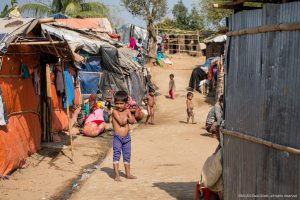Sono appena rientrata dopo essere stata a bordo della Phoenix dallo scorso 12 Aprile per partecipare alle operazioni SAR intraprese dal nostro team. Nonostante sia ormai la nostra quarta missione nel Mediterraneo Centrale dalla fondazione di MOAS nel 2014 e abbia già partecipato a diversi imbarchi e salvataggi, quello di cui sono stata testimone durante il weekend di Pasqua è una esperienza assolutamente senza precedenti anche per i più esperti in materia di migrazioni.

Dal primo salvataggio il 14 fino allo sbarco il 19 Aprile gli eventi si sono susseguiti ad una velocità inaspettata con il picco delle operazioni proprio fra sabato 15 e domenica 16. L’intero equipaggio MOAS ha lavorato strenuamente per oltre 24 ore al fine di salvare quante più vite umane e di non lasciare nessuno senza assistenza nel limite delle capacità disponibili. Ma se si è potuta evitare l’ennesima tragedia di massa in mare, lo dobbiamo anche allo spirito di collaborazione e al lavoro di squadra con altre due ONG come noi impegnate a pattugliare il Mediterraneo in cerca di imbarcazioni in difficoltà: Jugend Rettet con la nave Iuventa e Sea Eye. Oltre alle navi delle ONG, un ringraziamento va anche alla Guarda Costiera che ci ha assistito coordinando altre navi che si trovavano nelle vicinanze.
Impegnati in salvataggi multipli, tutti i membri dell’equipaggio MOAS hanno assistito fra le 1500 e le 1800 persone ammassate su 7 gommoni (in pessime condizioni al nostro arrivo) e 2 imbarcazioni in legno di cui 499 sono state portate a bordo della Phoenix con precedenza assoluta per donne con bambini, 15 donne incinte anche al nono mese, casi medici urgenti che richiedevano cure immediate fra cui un bambino di circa 11 anni con una paralisi che viaggiava col padre. Una volta raggiunta la capacità massima di accoglienza a bordo, la Phoenix non poteva più ospitare altre persone, ma non ha rinunciato alla sua missione di salvare vite.
Il SAR team è stato impegnato a stabilizzare le condizioni delle imbarcazioni che ancora ci circondavano al calar della notte, distribuendo i giubbotti salvagente e le razioni alimentari d’emergenza, monitorando che la situazione rimanesse stabile e aspettando le altre navi secondo gli ordini della Guardia Costiera. Con grande gioia tutte le persone da noi assistite direttamente o indirettamente si sono salvate.
Tuttavia, nel caso di una operazione di salvataggio collaterale in coordinamento con altre navi, abbiamo recuperato i corpi di 7 fratelli e sorelle che, come ha ben detto mio marito Christopher, “non sapranno mai cosa significhi la libertà”. Oltre ai corpi di 4 uomini e 2 donne c’era anche un bambino di circa 8 anni di cui non sappiamo nulla se non che, dentro il sacco mortuario, abbiamo chiuso anche la nostra moralità impotente di fronte alla sua ingiusta morte.
Nonostante la gioia per tutto quello che siamo riusciti a fare, è enorme il dolore e il senso di sconfitta nel chiudere quel piccolo corpo dentro un anonimo sacco che è poi stato sbarcato nel porto di Augusta il 19 Aprile 2017 per trovare sepoltura insieme agli altri 6 corpi nel cimitero di Siracusa.
Morte e vita si sono sfiorate e confrontate proprio nel weekend di Pasqua, giornate di resurrezione.
Così è stato anche per noi: da un lato il dolore per quei corpi senza vita e la frustrazione per non aver salvato tutti, dall’altro la gioia nel sentire i pianti dei bambini finalmente salvi a bordo che con la loro voce ci riportavano alle materiali esigenze della vita stessa. E quindi il tempo scorreva a distribuire coperte, ad asciugare chi era caduto in mare, a distribuire cibo ed acqua e i biberon per i molti bambini a bordo. Sono state somministrate cure urgenti ai più bisognosi e abbiamo assistito le tante madri mentre cambiavano e rifocillavano i propri figli.
Ogni bambino che perde la vita in mare o altrove è una morte di troppo di cui siamo tutti responsabili. Le lacrime di ogni madre che piange il proprio figlio appartengono ai nostri occhi. La disperazione di un padre che non ha come coprire o riscaldare la propria figlia deve essere la nostra disperazione. Potranno esserci centinaia di motivi a renderci diversi e separarci, ma c’è un unico grande motivo che rinnova la nostra fratellanza: siamo esseri umani.
Proprio questa umanità e fratellanza universale insieme al miracolo della Resurrezione sono state ricordate e celebrate durante la messa a bordo della Phoenix nel giorno di Pasquetta officiata da Padre Regamy della diocesi di Colonia. Padre Regamy è stato un prezioso conforto per tutti noi a bordo con le sue preghiere e con il suo coraggio nel non tirarsi mai indietro quando si tratta di aiutare gli altri.
Insieme a Padre Regamy, inoltre, il 19 Aprile sulla banchina del porto di Augusta abbiamo salutato le persone salvate nei giorni precedenti. Ci siamo accomiatati dai vivi, dai sopravvissuti con cui ormai avevamo creato un legame di affetto durante il tempo di permanenza a bordo, e abbiamo pregato per chi non ce l’ha fatta. Abbiamo anche accompagnato i salvati fino a dentro il centro di accoglienza temporanea al porto di Augusta, assistendo anche ad alcune procedure di identificazione e accoglienza della struttura.
E’ stato molto bello poter vedere i bambini che giocavano con le altalene, gli scivoli e altri giocattoli messi a disposizione per loro. Finalmente tutti avevano una brandina dove poter riposare i loro corpi esausti dopo il lungo viaggio. Tutto questo era reso possibile grazie alle istituzioni e alle organizzazioni umanitarie che collaboravano e amorevolmente si prendevano cura delle persone da noi salvate.
Infine, una volta terminate le procedure di sbarco e sanificazione della Phoenix, alle 19:30 siamo ripartiti dal porto di Augusta proprio mentre calava il tramonto.
[donate_button_blog]



